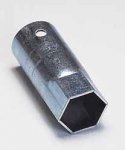D
dent
Guest
Tired searching the archives as i think there's something there but can't seem to get my seach working....
anyways, anyone know what the size of the hub nut is? I have a hub nut tool but am thinking of getting a proper deep socket for it where i can put a torque wrench to it and torque it down properly rather than guessing.
take care
sam
anyways, anyone know what the size of the hub nut is? I have a hub nut tool but am thinking of getting a proper deep socket for it where i can put a torque wrench to it and torque it down properly rather than guessing.
take care
sam
